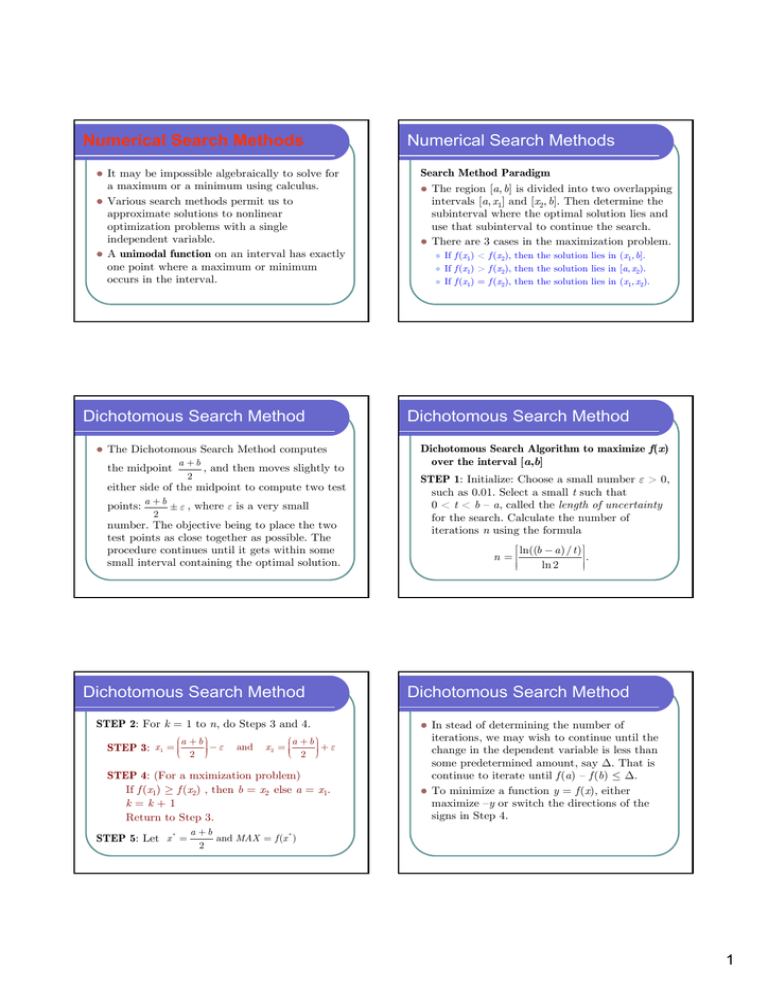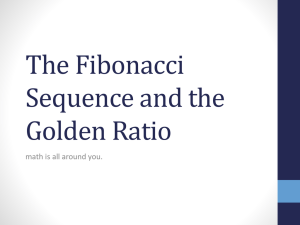Numerical Search Methods Numerical Search Methods
advertisement

Numerical Search Methods z z z It may be impossible algebraically to solve for a maximum or a minimum using calculus. Various search methods permit us to approximate solutions to nonlinear optimization problems with a single independent variable. A unimodal function on an interval has exactly one point where a maximum or minimum occurs in the interval. Dichotomous Search Method z The Dichotomous Search Method computes a +b the midpoint , and then moves slightly to 2 either side of the midpoint to compute two test points: a + b ± ε , where ε is a very small 2 number. The objective being to place the two test points as close together as possible. The procedure continues until it gets within some small interval containing the optimal solution. Dichotomous Search Method STEP 2: For k = 1 to n, do Steps 3 and 4. ⎛a + b ⎞⎟ STEP 3: x 1 = ⎜⎜⎝ ⎟− ε 2 ⎠⎟ and Search Method Paradigm z The region [a, b] is divided into two overlapping intervals [a, x1] and [x2, b]. Then determine the subinterval where the optimal solution lies and use that subinterval to continue the search. z There are 3 cases in the maximization problem. z z z If f (x1) < f (x2), then the solution lies in (x1, b]. If f (x1) > f (x2), then the solution lies in [a, x2). If f (x1) = f (x2), then the solution lies in (x1, x2). Dichotomous Search Method Dichotomous Search Algorithm to maximize f(x) over the interval [a,b] STEP 1: Initialize: Choose a small number ε > 0, such as 0.01. Select a small t such that 0 < t < b – a, called the length of uncertainty for the search. Calculate the number of iterations n using the formula ⎡ ln((b − a )/ t ) ⎤ ⎥. n=⎢ ln 2 ⎢⎢ ⎥⎥ Dichotomous Search Method z ⎛a + b ⎞⎟ x 2 = ⎜⎜ +ε ⎝ 2 ⎠⎟⎟ STEP 4: (For a mximization problem) If f (x1) ≥ f (x2) , then b = x2 else a = x1. k=k+1 Return to Step 3. STEP 5: Let x * = Numerical Search Methods z In stead of determining the number of iterations, we may wish to continue until the change in the dependent variable is less than some predetermined amount, say Δ. That is continue to iterate until f (a) – f (b) ≤ Δ. To minimize a function y = f (x), either maximize –y or switch the directions of the signs in Step 4. a +b and MAX = f (x * ) 2 1 Dichotomous Search Method Example Maximize f (x) = –x2 – 2x over the interval –3 ≤ x ≤ 6. Assume the optimal tolerance to be less than 0.2 and we choose ε = 0.01. z We determine the number of iterations to be ⎡ ⎛ 6 − (−3)⎞ ⎤ ⎟⎟ ⎥ ⎢ ln ⎜⎜ ⎢ ⎝⎜ 0.2 ⎠⎟ ⎥ ⎡ ln 45 ⎤ ⎥=⎢ n=⎢ ⎥ = ⎡5.49⎤ = 6 ln 2 ⎢ ⎥ ⎢ ln 2 ⎥ Golden Section Search Method z z The Golden Section Search Method chooses x1 and x2 such that the one of the two evaluations of the function in each step can be reused in the next step. The golden ratio is the ratio r satisfying r 1−r = 1 r ⇒ r= 5 −1 ≈ 0.618034 2 r (1 − r ) Golden Section Search Method Golden Section Search Method to maximize f (x) over the interval a ≤ x ≤ b. STEP 1: Initialize: Choose a tolerance t > 0. 5 −1 STEP 2: Set r = and define the test 2 points: x 1 = a + (1 − r ) (b − a ) x 2 = a + r (b − a ) STEP 3: Calculate f (x1) and f (x2). Dichotomous Search Method Results of a Dichotomous Search. z n a b x1 x2 f (x1) f (x2) 0 –3 6 1.49 1.51 – 5.2001 – 5.3001 1 –3 1.51 – 0.755 – 0.735 0.939975 0.929775 2 –3 – 0.735 – 1.8775 – 1.8575 0.229994 0.264694 3 – 1.8775 – 0.735 – 1.31625 – 1.29625 0.899986 0.912236 4 – 1.31625 – 0.735 – 1.03563 – 1.01563 0.998731 0.999756 5 – 1 .03563 – 0.735 – 0.89531 – 0.87531 0.989041 0.984453 6 – 1.03563 – 0.87531 x* = −1.03563 − 0.87531 = −0.95547 and f (x * ) = 0.99802 2 Golden Section Search Method y r1 = b − x1 r2 = b −a x1 a r1 = x2 b 1 − r2 r1 and r2 = r1 = r2 = 5 −1 2 1 − r1 r2 x x2 − a b −a Golden Section Search Method STEP 4: (For a maximization problem) If f (x1) ≤ f (x2) then a = x1, x1 = x2 else b = x2, x2 = x1. Find the new x1 or x2 using the formula in Step 2. STEP 5: If the length of the new interval from Step 4 is less than the tolerance t specified, then stop. Otherwise go back to Step 3. STEP 6: Estimate x* as the midpoint of the final interval x * = a +b and compute MAX = f (x*) 2 2 Golden Section Search Method z z z To minimize a function y = f (x), either maximize –y or switch the directions of the signs in Step 4. The advantage of the Golden Section Search Method is that only one new test point must be computed at each successive iteration. The length of the uncertainty is 61.8% of he length of the previous interval of uncertainty. Golden Section Search Method n a b x1 x2 f (x1) f (x2) 0 -3 6 0.437694 2.562306 -1.06696 -11.69 1 -3 2.562306 -0.87539 0.437694 0.984472 -1.06696 2 -3 0.437694 -1.68692 -0.87539 0.528144 0.984472 3 -1.68692 0.437694 -0.87539 -0.37384 0.984472 0.607918 4 -1.68692 -0.37384 -1.18536 -0.87539 0.96564 0.984472 5 -1.18536 -0.37384 -0.87539 -0.68381 0.984472 0.900025 6 -1.18536 -0.68381 -0.99379 -0.87539 0.999961 0.984472 7 -1.18536 -0.87539 -1.06696 -0.99379 0.995516 0.999961 8 -1.06696 -0.87539 -0.99379 -0.94856 0.999961 0.997354 9 -1.06696 -0.94856 -1.02174 -0.99379 0.999527 0.999961 10 -1.02174 -0.94856 -0.99379 -0.97651 0.999961 0.999448 11 -1.02174 -0.97651 x * = −0.99913 Golden Section Search Method How small should the tolerance be? If x * is the optimal point, then f (x ) ≈ f (x * ) + If we want the second term to be of a fraction ε of the first term, then 2 f (x * ) (x * )2 f ′′(x * ) MAX = 0.999999 Fibonacci Search Method z If 1 f ′′(x * )(x − x * )2 . 2 x − x* = ε x* and a number of test points is specified in advanced, then we can do slightly better than the Golden Section Search Method. z This method has the largest interval reduction compared to other methods using the same number of test points. . As a rule of thumb, we need x − x * ≈ ε x * . Fibonacci Search Method Fibonacci Search Method I n −2 I n −1 In αI n = εI 1 αI n xn In = x n −1 x n −2 1 1 I n −1 + αI n 2 2 ⇒ f (x n −2 ) > f (x n −3 ) In In xn I n −1 = (2 − α)I n f (x n −1 ) > f (x n −2 ) I n −1 f (x n −1 ) > f (x n −2 ) In x n −1 x n −2 x n −3 I n −2 = I n −1 + I n = (2 − α)I n + I n = (3 − α)I n 3 Fibonacci Search Method Fibonacci Search Method I n −1 = (2 − α)I n I 1 = (Fn +1 − Fn −1α)I n = Fn +1I n − Fn −1 (εI 1 ) I n −2 = I n −1 + I n = (2 − α)I n + I n = (3 − α)I n I1 I n −3 = I n −2 + I n −1 = (3 − α)I n + (2 − α)I n = (5 − 2α)I n I n −4 = I n −3 + I n −2 = (5 − 2α)I n + (3 − α)I n = (8 − 3α)I n I3 I2 # x1 a I n −k = (Fk +2 − Fk α)I n ⎛1 + F ε ⎞⎟ n −1 ⎟I I n = ⎜⎜⎜ ⎜⎝ Fn +1 ⎠⎟⎟ 1 I2 I3 x2 b x 1 = a + I 3 = a + (Fn −1 + Fn −3 α ) I n = a + Fn −1I n + Fn −3 (εI 1 ) where Fk +2 = Fk +1 + Fk , F1 = F2 = 1 Fibonacci Search Method z If ε = 0, then the formula simplify to In = I1 Fn +1 Fn −1 (b − a ) Fn +1 F x 2 = a + n (b − a ) Fn +1 x1 = a + x 2 = a + I 2 = a + (Fn + Fn −2 α ) I n = a + Fn I n + Fn −2 (εI 1 ) Fibonacci Search Method Fibonacci Search Method to maximize f (x) over the interval a ≤ x ≤ b. STEP 1: Initialize: Choose the number of test points n. STEP 2: Define the test points: x1 = a + Fn −1 F (b − a ), x 2 = a + n (b − a ) Fn +1 Fn +1 STEP 3: Calculate f (x1) and f (x2). Fibonacci Search Method STEP 4: (For a maximization problem) If f (x1) ≤ f (x2) then a = x1, x1 = x2 else b = x2, x2 = x1. n = n – 1. Find the new x1 or x2 using the formula in Step 2. STEP 5: If n > 1, return to Step 3. STEP 6: Estimate x* as the midpoint of the final a +b interval x * = 2 and compute MAX = f (x*) Fibonacci Search Method n Fn 13 233 a b x1 x2 f (x1) f (x2) -11.6895 12 144 -3 6 0.437768 2.562232 -1.06718 11 89 -3 2.562232 -0.87554 0.437768 0.984509 10 55 -3 0.437768 -1.6867 -0.87554 0.52845 0.984509 9 34 -1.6867 0.437768 -0.87554 -0.37339 0.984509 0.607361 8 21 -1.6867 -0.37339 -1.18455 -0.87554 0.965942 0.984509 7 13 -1.18455 -0.37339 -0.87554 -0.6824 0.984509 0.899132 6 8 -1.18455 -0.6824 -0.99142 -0.87554 0.999926 0.984509 5 5 -1.18455 -0.87554 -1.06867 -0.99142 0.995284 0.999926 4 3 -1.06867 -0.87554 -0.99142 -0.95279 0.999926 0.997771 3 2 -1.06867 -0.95279 -1.03004 -0.99142 0.999097 0.999926 2 1 -1.03004 -0.95279 -0.99142 -0.99142 0.999926 0.999926 1 1 -1.03004 -0.99142 x * = −1.01073 and -1.06718 MAX = 0.999885 4

